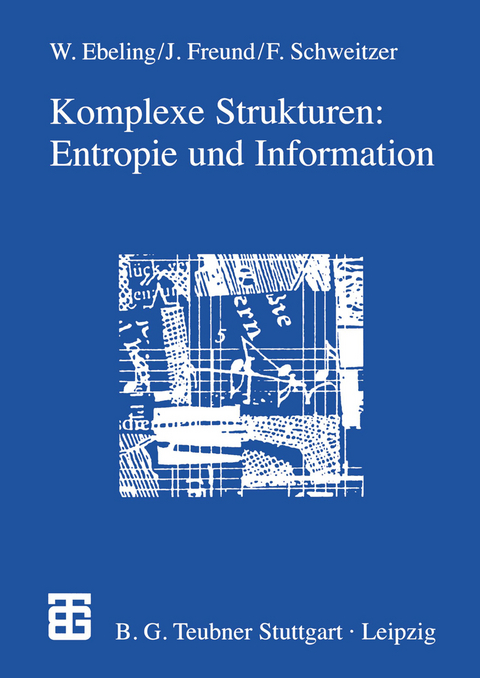
Komplexe Strukturen: Entropie und Information
Vieweg & Teubner (Verlag)
978-3-322-85168-0 (ISBN)
Prof. Dr.-Ing. Frank Schweitzer lehrt Bodenmechanik und Grundbau an der FH München und ist außerdem als Sachverständiger tätig.
1 Komplexität und Entropie.- 1.1 Struktur und Ordnung.- 1.2 Was sind komplexe Strukturen?.- 1.3 Komplexität als Phänomen.- 1.4 Quantifizierimg der Komplexität.- 1.5 Thermodynamische Entropie.- 1.6 Statistische und informationstheoretisehe Entropie.- 1.7 Entropie und Vorhersagbarkeit.- 2 Selbstorganisation und Information.- 2.1 Entropie und potentielle Information.- 2.2 Entropie und Selbstorganisation.- 2.3 Zur Evolution der Informationsverarbeitung.- 2.4 Gebundene und freie Information.- 2.5 Strukturelle und funktionale Information.- 2.6 Pragmatische Information.- 2.7 Information und Kommunikation.- 2.8 Selbstorganisation durch Information in einem Agentenmodell.- 2.9 Kollektive Information.- 3 Informationstheoretische Maße.- 3.1 Nachrichten und Kommunikation.- 3.2 Informationsquellen.- 3.3 Das Shannonsche Informationsmaß.- 3.4 Dynamische Entropien.- 3.5 Sequenzen mit langem Gedächtnis.- 3.6 Bedingte Entropien und Komplexität.- 3.7 Kullback-Information und Transinformation.- 3.8 Rényi -Entropien.- 3.9 Thermodynamischer Formalismus.- 4 Dynamisch generierte Strukturen.- 4.1 Strukturen und Symbolsequenzen.- 4.2 Symbolische Dynamik.- 4.3 Stationarität und Ergodizität.- 4.4 Kolmogorov-Sinai-Entropie.- 4.5 Der Satz von McMillan.- 4.6 Die Feigenbaum-Route ins Chaos und Intermittenz.- 4.7 Selbstähnliche und intermittente Symbolsequenzen.- 4.8 Ein Komplexitätsvergleich.- 5 Entropie und Komplexität natürlicher Sequenzen.- 5.1 Symbolfolgen und Symbolische Dynamik.- 5.2 Blockentropie und bedingte Entropie.- 5.3 Maße für Komplexität und Vorhersagbarkeit.- 5.4 Das Fibonacci-Modell der Evolution komplexer Folgen.- 5.5 Analyse natürlicher Sequenzen.- 5.6 Struktur von Texten, Notenfolgen und Biosequenzen.- 5.7 Diskussion der Komplexität natürlicher Symbolfolgen.- 6Quantitative Ästhetik.- 6.1 Naturwissenschaft und Ästhetik: Fünf Standpunkte.- 6.2 Versuche einer quantitativen Ästhetik.- 6.3 Birkhoffs mathematische Theorie der Ästhetik.- 6.4 Statistische Analysen von Sprache und Stil.- 6.5 Informationstheorie und Ästhetik.- 6.6 Grenzen der quantitativen Ästhetik.- 6.7 Ein Fazit am Schluß.- Literatur.- Namen- und Sachverzeichnis.
| Erscheint lt. Verlag | 14.2.2012 |
|---|---|
| Co-Autor | Werner Ebeling |
| Zusatzinfo | 265 S. |
| Verlagsort | Wiesbaden |
| Sprache | deutsch |
| Maße | 162 x 229 mm |
| Gewicht | 424 g |
| Themenwelt | Mathematik / Informatik ► Mathematik ► Wahrscheinlichkeit / Kombinatorik |
| Naturwissenschaften ► Physik / Astronomie ► Theoretische Physik | |
| Naturwissenschaften ► Physik / Astronomie ► Thermodynamik | |
| Technik ► Maschinenbau | |
| Schlagworte | Algorithm analysis and problem complexity • Entropie • Information • Informationstheoretische Maße • Komplexität • natürliche Sequenz • Quantitative Ästhetik • Reibung |
| ISBN-10 | 3-322-85168-0 / 3322851680 |
| ISBN-13 | 978-3-322-85168-0 / 9783322851680 |
| Zustand | Neuware |
| Haben Sie eine Frage zum Produkt? |
aus dem Bereich


